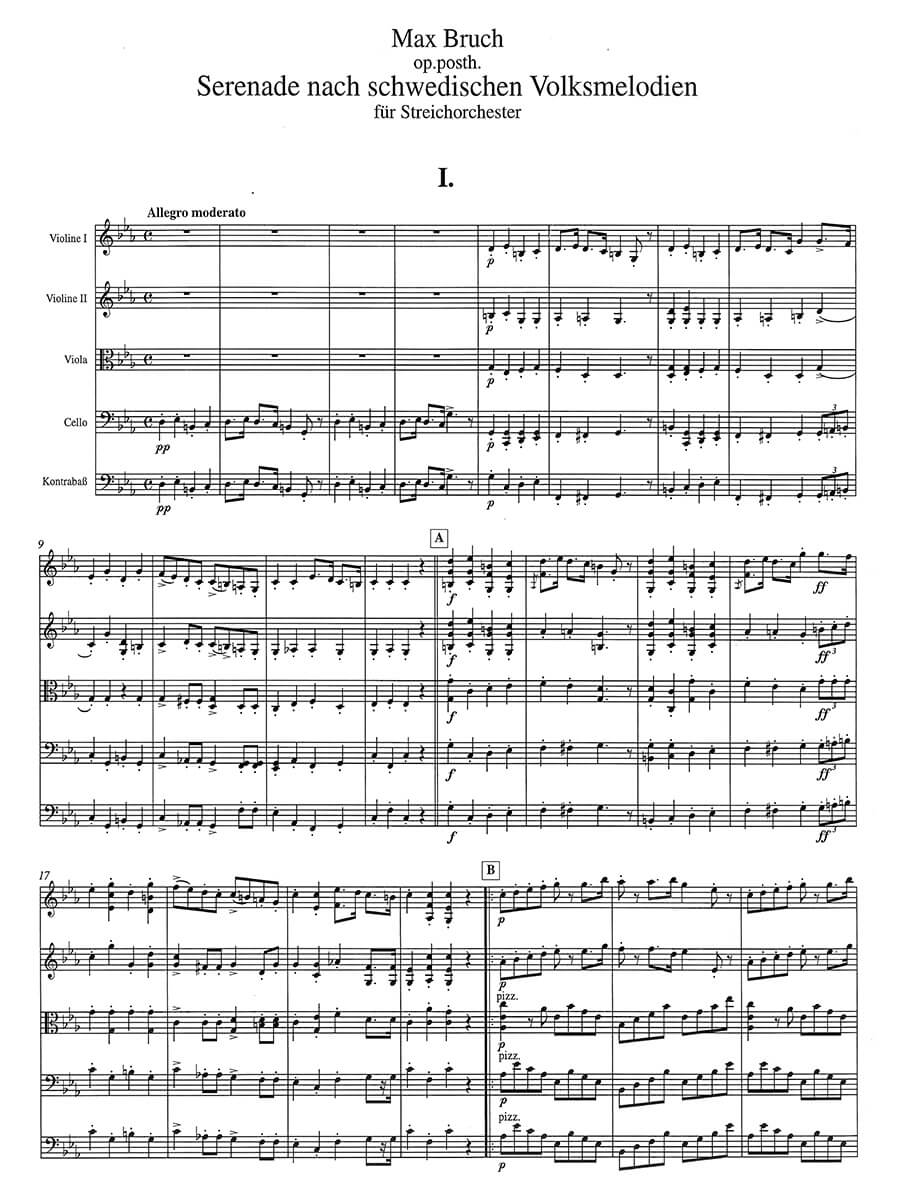Serenade for Strings after Swedish Folk Melodies, Op.posthum
Bruch, Max
14,00 €
Preface
Max Bruch – Serenade for Strings after Swedish Folk Melodies op. posth.
(Born Cologne, 6 January 1838 – died Friedenau, 20 October 1920)
Preface
Do the creative powers of a composer diminish with old age? Max Bruch is commonly cited as an example. By the time of the completion of the Serenade for Strings (we consciously avoid the term ‘composition’ here), some half a century after beginning his famous Violin Concerto in G Minor, he had already reached the advanced age of 78. Beset by illness, far from free of financial woes and frustrated by the realisation that the course of music had overtaken him within his own lifetime, consigning him more or less to the sidelines, Bruch observed the world around him not only critically, but also with an element of bitterness. In an interview he conceded that when in a few years’ time the discussion came to great composers, Brahms’ name would justifiably be mentioned, but not his own.
Yet Bruch was by no means ready to retire from composition. Even in his last years, he still produced multiple works, and perhaps even more than the number which have been handed down to us, since some manuscripts were lost or still await rediscovery in the archives. In the late works that have survived, however, Bruch tends to draw on older musical material, so that some represent more of a re-arrangement than new creation. This is the case with the Serenade for Strings.
Bruch’s fondness for simple, unpretentious melodies was echoed in his use of folk songs, which he eagerly studied and adapted for his works. A prime example of this is the 1903 collection of nine songs and dances after Russian and Swedish melodies for violin and piano (op. 79) which was published by Simrock Verlag in the same year. Simrock had already published Bruch’s 16 Swedish Dances (op.63) some years before for the same instrumentation. Healthy sales allowed Bruch to immediately write an orchestration for the Swedish Dances, and, based on op. 79, he decided to compose two orchestral suites of five movements for large scale orchestra. Yet this time it was not just a case of simple instrumentation, but a more comprehensive revision, which also included new musical material. While the first suite adopted elements of Russian songs, the second suite was based on Swedish. Bruch completed the two suites between 1904 and 1906, however only the first suite was published, appearing with Simrock as op. 79b under the title Suite after Russian Folk Melodies. The second suite was first performed on 10 March 1906 in Barmen, yet trace of it is lost soon after. Its manuscript was entrusted by Bruch’s descendants to the publisher Rudolf Eichmann at the beginning of the Second World War and appeared with Eichmann for the first time in 1956 in an edition entitled Nordland Suite, which is probably based on this manuscript score. The original manuscript has not reappeared to this day.
Nevertheless, as late as 1916 Bruch must still have been in possession of the manuscript for the suite, since it was this work that clearly served as a model for the Serenade for Strings. The manuscript for the Serenade is also now lost, it too was probably among those which were given by Bruch’s descendants to Eichmann. Fortunately, a copyist’s version of the work and string parts partially written by Bruch himself were found at it his final workplace before retirement, the Berlin Hochschule für Musik. Sadly, nothing is known of the occasion for which the Serenade for Strings was written. However, by comparing the copyist’s version with the published edition of the Nordland Suite, we can see how Bruch went about his reworking. The last four movements of the Suite were carried over into the Serenade. The March, originally only at the end of the piece, also appears in a lightly modified form as the first movement of the Serenade, fully in keeping with the serenade tradition of processional and recessional music. It is inspired by the Coronation March for Charles XII (c. 1700). The other movements were given tighter form by the exclusion of repeats and introductory sections. The second and fourth movements take two love songs as their theme while the third movement draws on a Dalecarlian dance (Dalecarlia/Dalarna, a historical province in central Sweden). In addition, the instrumentation had of course to be modified, with the large scale orchestra replaced by a small string ensemble.
Even if Bruch may not have possessed the same imaginativeness seen in his earlier years, we can still recognise the seasoned composer at work in this arrangement. He transforms the rich sound of the full orchestra into the more intimate one of the string ensemble with great subtlety, almost as if the work had never been conceived for a different setting. The Serenade for Strings was first published in this form in 1997 (Edition Kunzelmann). While no recordings of the earlier compositions from which the Serenade originated are currently available, the Serenade itself has since been recorded several times. Let us hope that this edition may help focus future interest in Bruch’s music beyond solely his first violin concerto.
Wolfgang Eggerking, 2015
For information on performance materials, please contact Boosey & Hawkes, Berlin.
Score Data
| Edition | Repertoire Explorer |
|---|---|
| Genre | String Orchestra |
| Size | 225 x 320 mm |
| Printing | Reprint |
| Pages | 24 |
